Hello,
We have recently had a discussion on the ratio of VFR to IFR content on this site. I had what I consider my best flying day so far (since my first flight in January last year) and I thought it’s a good idea to share some impressions from that day.
There’s also a sentimental value attached to this trip: Invariably, when people ask me how I came to fly, I recount – in varying degrees of detail – the anecdote of how some four or five years ago, I was visiting my parents on the island of Borkum. This is the largest and the most western of the East Frisian islands, just short of the Dutch border. I spent two nights at a hotel near the local airfield and one afternoon, I was watching the airplanes come in and out and thought to myself: ‘Boy, that would be cool to just fly here for an afternoon every now and then…’ Nowadays, I believe that afternoon ignited my motivation to learn how to do this.
So when my best friend approached me earlier this year and announced he was going to stay on Borkum for a week with his girlfriend in early March, I was hooked on the idea of flying them there instantly. We planned the trip, always having in mind the low chances of flyable weather in March for this kind of journey for a low-hours pilot. I actually got some valuable tips while planning this first island flight of mine here on euroga.
As the 10th of March came closer, my confidence rose steadily. Forecast weather was nothing short of perfect. The entire weekend and large parts of the following week were blessed by that high pressure area that brought CAVOK and generally pretty fair weather to large parts of Europe. The evening before, I ferried the rental C172 over from its home base Essen/Mülheim EDLE to Niederrhein EDLV. This short flight in busy Sunday afternoon air allowed me to visit family on Sunday evening and meet with my two passengers for the next day and plan the adventure together (actually, I had completed all planning and brought print outs for the following day as meticulously as I could because my friend was a bit of a worried passenger and I wanted to reassure him of the superb conditions).
I arrived just a few minutes before sunset and was greeted by a follow-me car in EDLV (I had previously arranged my arrival and the next day departure with the local handling agency “Solid Handling”). I met the guy who runs the handling agency briefly (a nice Dutch guy) and said Good-Bye until tomorrow. D-ECZV received a nice, lonely parking lot near one of the old military hangars that tell stories of EDLV’s past as an RAF airbase.
The next day began with a generally very good experience at EDLV. This was my first trip that involved a handling agent. I was always put off by the amount and in-transparency of the fees that other pilots report of. But Solid Handling was a fair surprise to me (not really, as I had received a quote for what I was going to do beforehand). The actual handling fee was 15 EUR. Further fees were: landing 5 EUR, overnight parking non-hangar 4,50 EUR, security fee per passenger 4,50 EUR and an ATC fee of 5 EUR – all excluding VAT.
For 15 EUR, Solid Handling provided the Follow-Me car pick-up, shuttle from and to the aircraft (three times), organizing the fuel service, guiding us through the crew security checks (avoiding the RyanAir crowds…) and access to their “executive lounge” (aka waiting room/back office) for all three of us including coffee, cold drinks, and koffiekoekjes. I’ll definitely come back!
I had the AVGAS guy top up only 5 liters in each tank for a total of 90 liters – that way we had a comfortable endurance of more than two hours for a planned flight time of a little more than an hour (in the unlikely event of deteriorating weather conditions in EDWR), while still keeping the aircraft within its W&B limits. This was close enough: My friend is not the lightest fellow and both passengers brought what I thought was a bit too much luggage for a 5-day island trip. Luckily, we were able to use the weighing scales from the airline check-in counters, so I could work with actual numbers rather than estimating the weights.
The following three images show the Solid Handling executive lounge (and me filing the flight plan for our trip through The Netherlands) and D-ECZV being refueled.
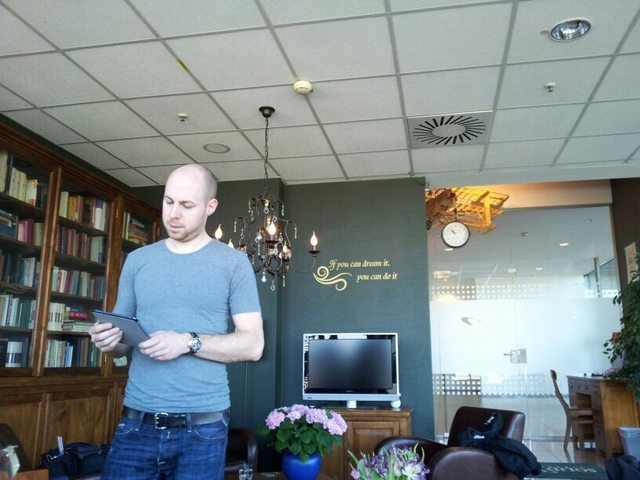

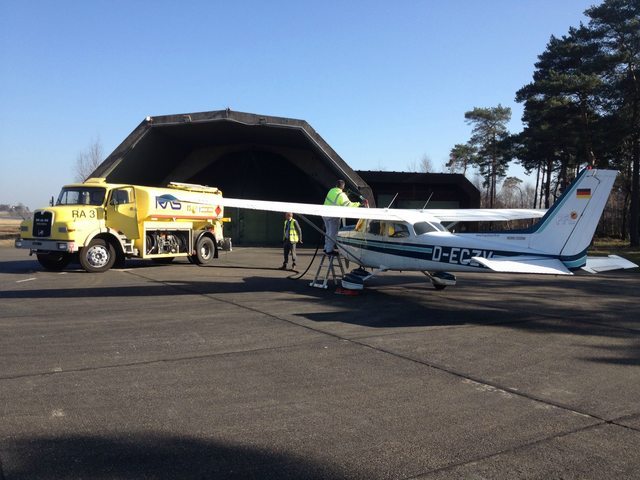
After having completed the pre-flight checks (alone, while the PAX were still waiting in the lounge, for ease of mind), loading of the aircraft and finally being all seated, there was a bit of an ambiguous situation. The handling agent told me to request a start-up clearance. I thought this was odd, as it wasn’t mentioned in the airport documents and as far as I know, it’s not usually done when the only station available is “TOWER”. It also broke my checklist order, which irritated me. D-ECZV is not equipped with an EFIS – hence avionics are usually turned on after start-up. I didn’t feel comfortable using the radio on the battery. I did it anyway, only to get a slightly irritated response from the controller, telling me to just start-up at my discretion.
Take-off itself was uneventful. The following pictures show the city of Goch soon after take-off, the road junction that makes up VRP November, and Emmerich Rhine Bridge after having established ourselves on a northerly course.


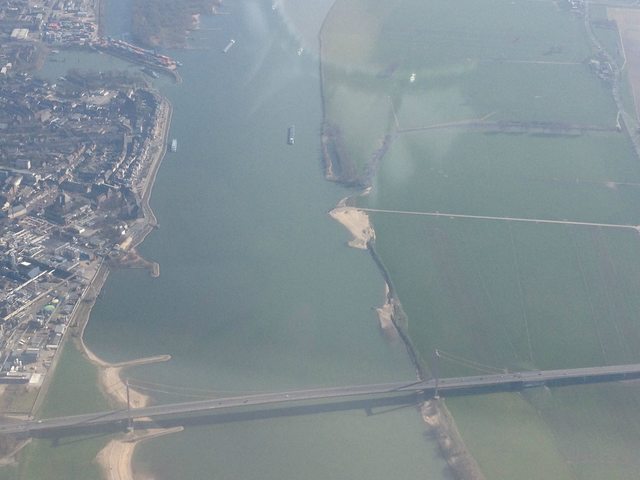
Visibility in the air was not as nice as it looked from the ground – I suppose a phenomenon not unheard of for such high pressure days. Still, it was beautiful flying with a cloudless sky. So far, on most of my trips here, I have been below 2500 ft due to cloud and/or airspace – quite in contrast to the altitudes I was used to from my training in California, where 6000-8000 ft. was more common. Now, I was able to fly on FL 55 and enjoyed the added time buffer to select one of the many fields in rural Holland in case of an engine failure…
We were on Dutch MIL Info for most part of the en route phase. There was almost no traffic at all (it was a Monday). We didn’t see any other aircraft (apart from airliners high above) and the only other traffic we heard on the radio was in- and outbound of EHLE. This was the second time my best friend flew with me, and he was getting now much more relaxed. Sitting on the RHS, he was eager to help and I let him setup the next frequencies on the GNS 430 throughout the flight. Although due to the high altitude, we were not crossing Eelde CTR, however we were crossing Eelde TMA and overflying EHGG mid-field and I expected to be handed over at some point to Eelde Tower, but we stayed on Dutch MIL Info all the way until leaving the FIR/country again.
The following pictures show Assen racetrack, EHGG, and our first view of the North Sea and Eemshaven.



We contacted Borkum Info as soon as the island was in sight. The two grass strips were still closed. Runway 31 was in use. We let the island and the main town to our right (which was good for some pictures, see below) and approached the downwind leg from the North. Not being used to such enormously  high altitudes anymore, I had underestimated the time required for a gentle descent. I decided to get rid of some altitude with an extra 360 over the sea – the passengers enjoyed it because it allowed them some extra nice views. I had been a bit worried about crosswinds, but the landing was absolutely fine – by my own modest standards.
high altitudes anymore, I had underestimated the time required for a gentle descent. I decided to get rid of some altitude with an extra 360 over the sea – the passengers enjoyed it because it allowed them some extra nice views. I had been a bit worried about crosswinds, but the landing was absolutely fine – by my own modest standards. 
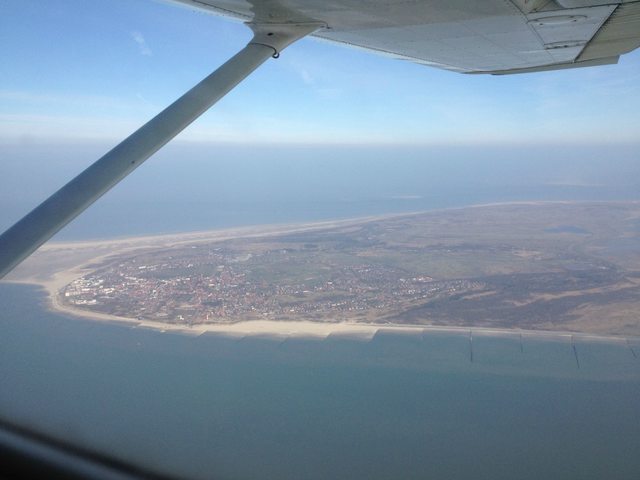
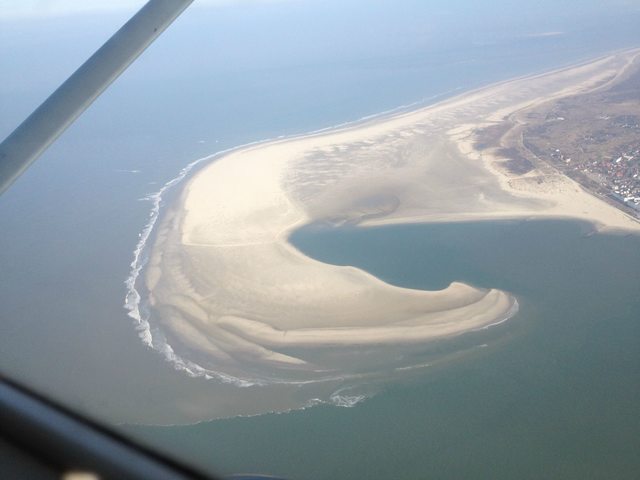
I spent 3 hours and 27 minutes on the island. During that time, I rented a bicycle from the airfield for 7,50 EUR, rode into town (4 km), took a photo of the beach, had fish for lunch with my friends (the entire island seems to offer “Große Speisen zu kleinen Preisen”), rode back to the airfield, briefed myself for the return flight alone, refueled the aircraft, chatted with a local pilot and helped him pull his C182 into the hangar, worried a bit about the worsening visibility, and went off. This felt like a fast-forward holiday indeed, but it also was my “proof-of-concept” that one-day trips to the islands ARE possible and enjoyable with a small airplane. In fact, in my opinion, from where I’m based, this is the ONLY setup where flying has an increased utility value over land and sea-based transport. A day trip involving a long drive to the ferry docks, waiting for the ferry, spending an hour on the ferry etc. is just not feasible – one would want to stay at least one night.
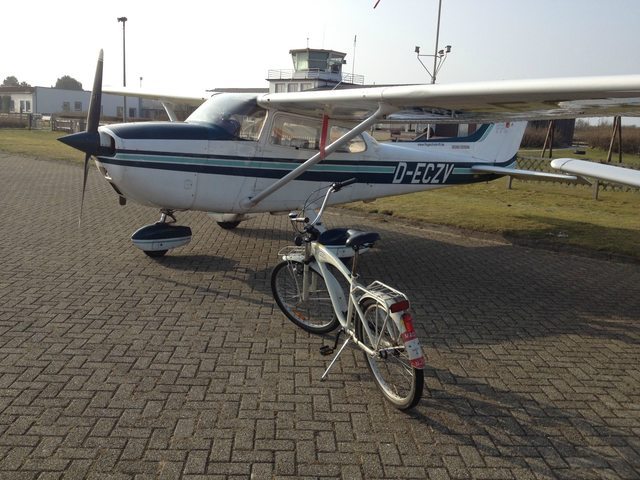
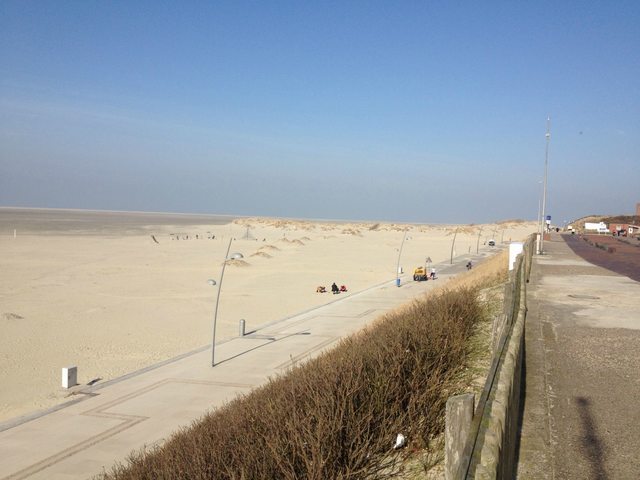
In the afternoon, visibility deteriorated and in the end, I hurried out, fearing that I might be stuck on the island. For that case and to oppose get-home-itis, I had taken the following Tuesday as an optional day off work. I just about made it out – in what was the most marginal conditions I have been in. I was rewarded with some beautiful VFR over the top for a little while in the Northern part of the Netherlands. When flying locally, I usually don’t get to do this because I don’t find ways to climb on top and I cannot be sure to find a way to descent below in VMC. In this case, I knew that my destination EDLE and all fields around were absolutely CAVOK and indeed I arrived back home just before a very nice and clear sunset.
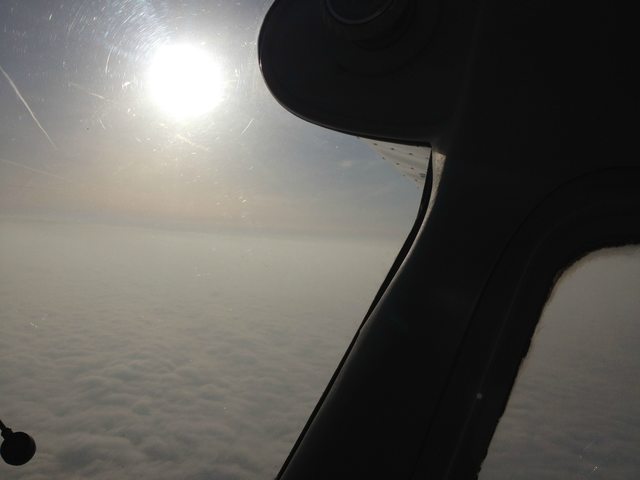

Cheers,
Patrick
Thanks for that Patrick, it’s enjoyable to read such a well written report.
I can imagine you’d get a lot out of a trip like that, coming ‘full circle’ back to your original motivation to fly after traveling half way around the world to train. It’s interesting and enjoyable for me that by chance, people post aerial photos of places I’ve been on the ground – I was at Assen racetrack in 1989 and again in 1998. Seems like yesterday.
Offshore islands are a good reason to fly 
Well done, Patrick! It takes a lot of confidence to start doing cross country flights on your own, after getting the PPL. But nothing is more rewarding than arriving at your destination, all by yourself 
I would always request startup at a controlled airport. Maybe for Niederrhein EDLV it does not matter, but for larger airport it does. There could be a delay to expect, etc.
If you worry about the aircraft battery: Just buy a portable radio. You can find them under 200EUR and it is very handy to listen out the ATIS, request startup, etc.
In the Eelde TMA, the FIS is done by Eelde Approach. The thing is that Dutchmil does not bother about VFR traffic. They even have campaigns that VFR pilots should not call them on the radio, just listen out. Because: “If we need you, we will call you” 
So you could have just done: “D-ECZV is leaving your frequency, switching to Eelde Approach”.
Eelde Approach (120.300) would have given you proper FIS service…
Borkum is a bit different from others, in that they usually instruct you to fly a straight-in approach. This can be difficult as you miss the references you normally get when flying a circuit. Best thing to do is to use a GPS, set an extended centerline to the airfield (OBS function), and use the distance to the field to determinate when to start descending.
The rule is that you need 300ft for each NM to do a normal 3 degree glidepath. So if you are at 2400ft, you start the descent at 8NM out, at 1500ft start at 5NM out, etc etc.
Brilliant work and a great report 
I like the packed beach…
And the VMC on top bit. That is real going-places flying.
Thanks for the practical advice, lenthamen. I’ll contact Eelde Approach on my own initiative then, next time. I’ve realized on both my trips to/through NL so far that Dutch Mil is friendly enough, but not really enthusiastic about anything more than having me on their frequency and having me leave again. 
This time, Borkum wasn’t very busy (I suspect that’s VERY different on a sunny weekend day as opposed to a weekday) and I told Borkum Info about my plans to go around the island once and enter the pattern via downwind, they didn’t object.
I like the packed beach…
Indeed. In fact, the entire island seemed to have been taken by surprise with respect to the early season opening. Lots of restaurants closed in the afternoon, most of the rental bicycles at the airport not yet fixed, not a whole lot of people out generally…
Great report Rhino!
In France, the ATIS usually specifies if a start-up clearance is required.